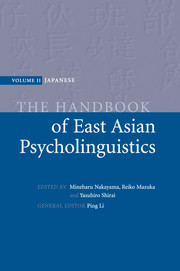Book contents
- Frontmatter
- Contents
- List of figures
- List of contributors
- In memory of Miwa Nishimura
- Preface
- Introduction
- Language acquisition
- 1 Ontogeny of language
- 2 Caregivers' speech
- 3 The intrinsic link between gesture and speech at the prelinguistic stage
- 4 Infant speech perception
- 5 Phonological acquisition
- 6 The mechanism of lexical development: implications from Japanese children's word learning
- 7 The acquisition of nouns and verbs in Japanese
- 8 The acquisition of verbal nouns
- 9 The acquisition of Japanese numeral classifiers
- 10 The acquisition of case markers
- 11 The acquisition of tense and aspect
- 12 On the origin of children's errors: the case of Japanese negation and direct passive
- 13 Binding Theory in UG and first-language acquisition of Japanese
- 14 The acquisition of the particles ne, yo, and no
- 15 The acquisition of linguistic politeness in Japanese
- 16 Children's narrative structures
- 17 Memory talk and testimony in children
- 18 Developmental dyslexia
- 19 Japanese Sign Language
- 20 The role of an innate acquisition device in second-language acquisition
- 21 Japanese, the grammar of reflexives, and second-language acquisition
- 22 Processes in L2 Japanese sentence production
- 23 The development of lexical competence among second-language readers
- 24 Reading in Japanese as a second language
- 25 Intrasentential code-switching in Japanese and English
- Part II Language processing
- References
- Name index
- Subject index
19 - Japanese Sign Language
from Language acquisition
Published online by Cambridge University Press: 05 June 2012
- Frontmatter
- Contents
- List of figures
- List of contributors
- In memory of Miwa Nishimura
- Preface
- Introduction
- Language acquisition
- 1 Ontogeny of language
- 2 Caregivers' speech
- 3 The intrinsic link between gesture and speech at the prelinguistic stage
- 4 Infant speech perception
- 5 Phonological acquisition
- 6 The mechanism of lexical development: implications from Japanese children's word learning
- 7 The acquisition of nouns and verbs in Japanese
- 8 The acquisition of verbal nouns
- 9 The acquisition of Japanese numeral classifiers
- 10 The acquisition of case markers
- 11 The acquisition of tense and aspect
- 12 On the origin of children's errors: the case of Japanese negation and direct passive
- 13 Binding Theory in UG and first-language acquisition of Japanese
- 14 The acquisition of the particles ne, yo, and no
- 15 The acquisition of linguistic politeness in Japanese
- 16 Children's narrative structures
- 17 Memory talk and testimony in children
- 18 Developmental dyslexia
- 19 Japanese Sign Language
- 20 The role of an innate acquisition device in second-language acquisition
- 21 Japanese, the grammar of reflexives, and second-language acquisition
- 22 Processes in L2 Japanese sentence production
- 23 The development of lexical competence among second-language readers
- 24 Reading in Japanese as a second language
- 25 Intrasentential code-switching in Japanese and English
- Part II Language processing
- References
- Name index
- Subject index
Summary
Signed language is a natural language that uses a visual–gestural mode of communication, instead of the aural–oral mode used in spoken languages. Recent linguistic research on the structure of signed languages has revealed that they are full-fledged languages, comparable to spoken languages (Klima & Bellugi, 1979; Padden, 1988; Sandler, 1989; Lillo-Martin, 1991). From a linguistic and psychological point of view, it is important to investigate how deaf children acquire these languages. Through observing their developmental processes, we can obtain a more comprehensive picture of how human language is acquired.
In the field of sign linguistics, American Sign Language (ASL), the native language of North American deaf communities, has been studied most extensively thus far. ASL is just one language, different from other signed languages, for example, from Japanese Sign Language (JSL), the natural language used in the Deaf community in Japan. One example of this difference shows that in ASL, the dominant word order is subject–verb–object (SVO), while in JSL it is subject–object–verb (SOV). Some linguistic structures discussed below, however, are shared among different signed languages. Crosslinguistic comparison among signed languages as well as between signed and spoken languages is important, but has not been performed systematically so far, because no other signed languages than ASL have been investigated extensively.
This chapter discusses some important findings from recent research on JSL development. First, I present an overview of JSL structure.
- Type
- Chapter
- Information
- The Handbook of East Asian Psycholinguistics , pp. 137 - 143Publisher: Cambridge University PressPrint publication year: 2006

